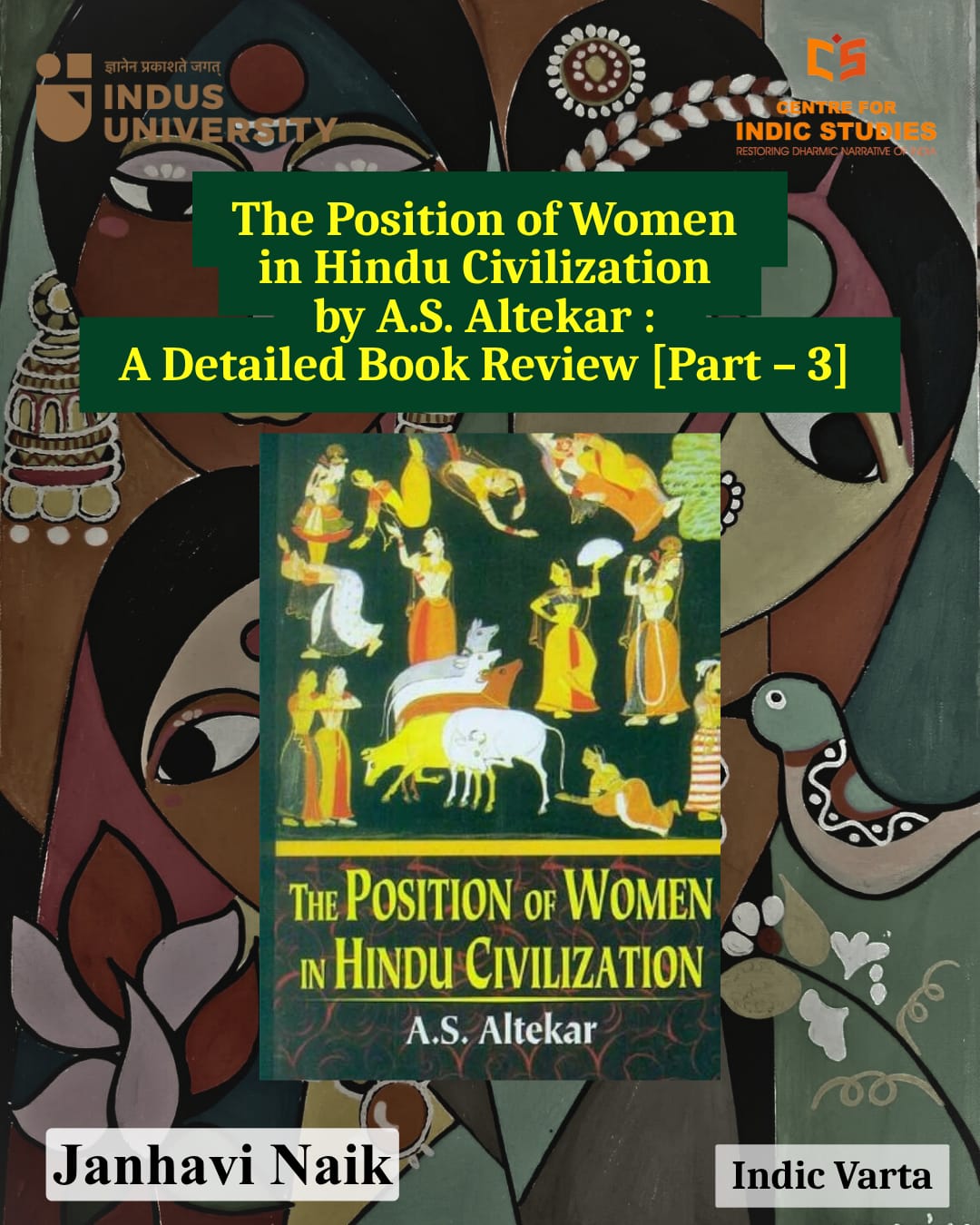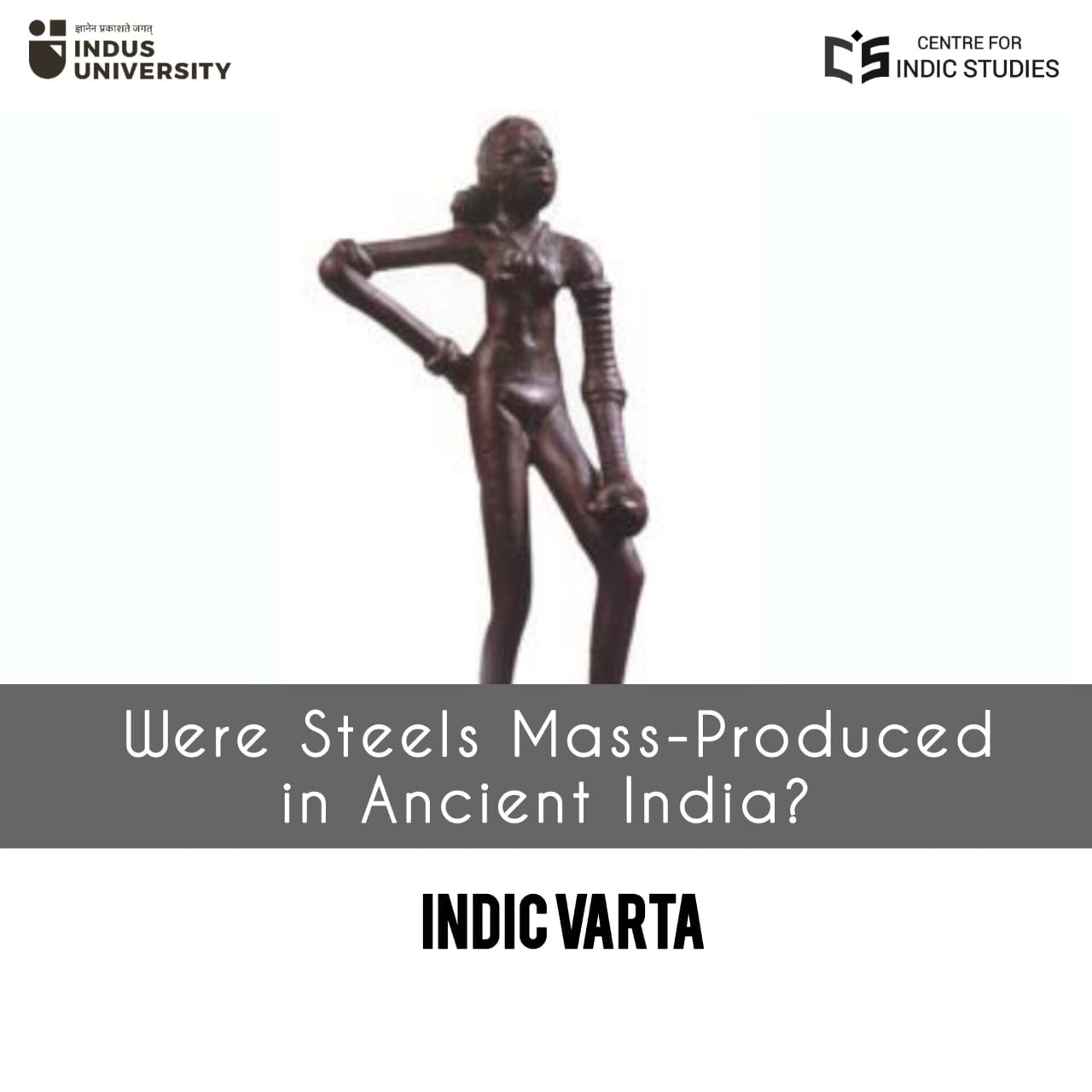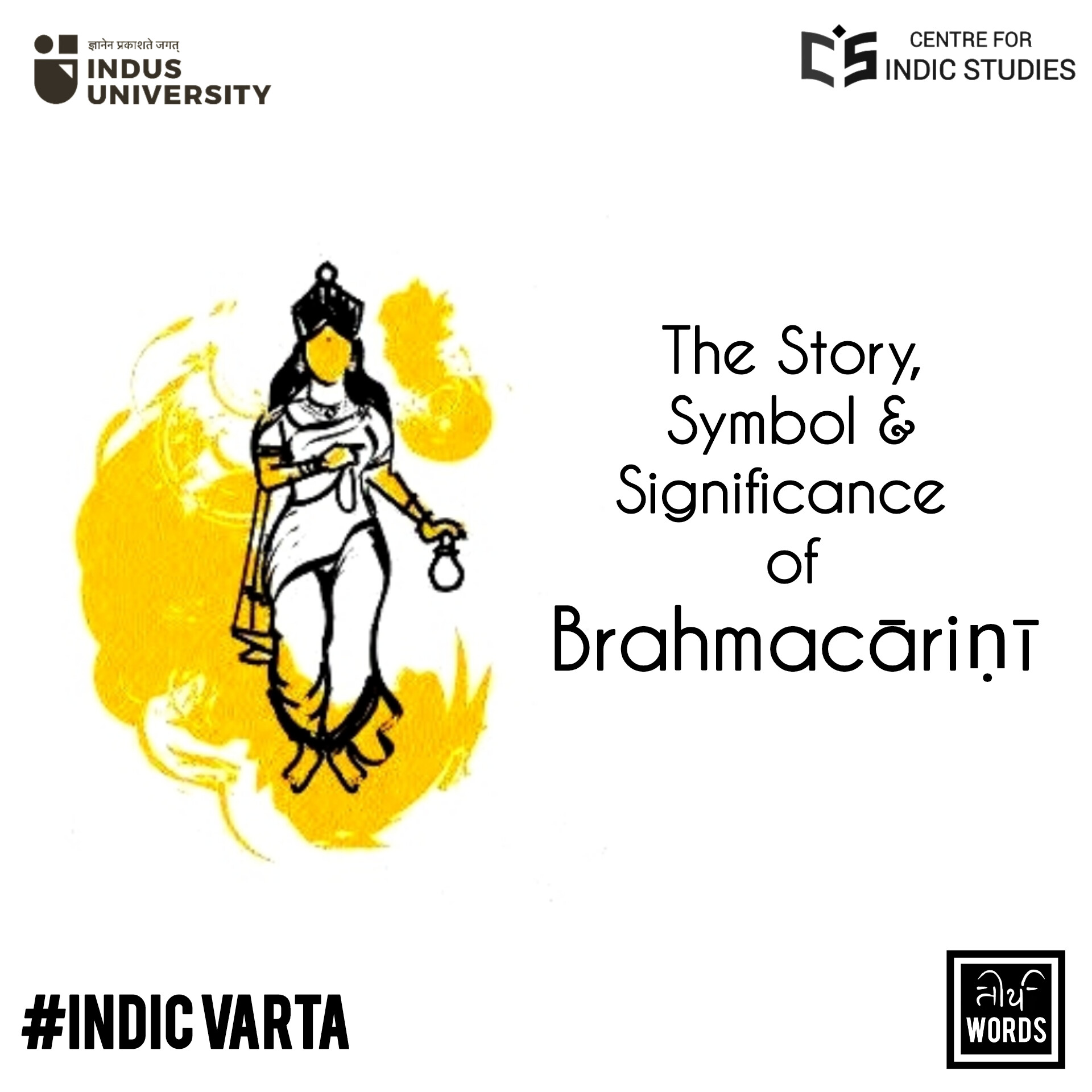- Visitor:9
- Published on: 2025-11-17 01:51 pm
The Position of Women in Hindu Civilization by A.S. Altekar: A Detailed Book Review [Final Part]
By now, the mist of brainwashing must surely have begun to fade from the minds of youth…I guess; because the truth, through facts and references, imparted by Altekar is not just flabbergasting in its disposition but can transform our entire perspective towards how social systems and cultural traditions have been portrayed and presented in front of us. Certain imperative concepts are left to be discussed; those are discussed here to deepen the understanding about certain customs and to clarify certain misunderstandings pertaining to it…

The
Dowry Custom: An Exceptional Custom Deliberately Framed as a System to Demean
Hindu Society
Altkear clarifies the noisy narrative of the dowry custom
not being an obstruction in daughter's marriage in ancient India. He describes,
in prehistoric times women were regarded as chattel (a movable asset) and so it
was the bride's father, and not the bridegroom's, who was regarded as justified
in demanding a payment at the time of marriage. The bridegroom carried away the
bride and deprived her family of her services. He could not have dreamt of
demanding a further dowry or donation. Such a request was considered as
unreasonable.
Dowry custom, as the author says, was generally unknown in
early societies, and the same was the case with ancient Hindus. He further
describes how rich and royal families used to give some gifts to sons-in-law at
the time of marriage and Atharvaveda too refers to royal brides, bringing with
them a hundred cows. The author mentions Draupadi, Subhadra and Uttară who
brought expensive gifts to their homes after marriage. He adds – “The Jätakas often describe how very valuable presents were given
to the bridegroom when rich merchants like the father of Višäkhä sent their
daughters to their husband's homes. Inscriptions often refer to rich marriage
presents given at the time of the marriages of princes………These presents,
however, can hardly be called dowries, for they were voluntarily made after the
marriage, out of pure affection. There are no references either in Smritis or
in dramas to the dowry, i. e., to a prenuptial contract of payment made by the
bride's father with the bridegroom or his guardian. If the custom had prevailed
to anything like its present extent, it would have been very vehemently
condemned by Smriti writers …… We meet with no such condemnation….. Smritis, no
doubt, recommend that the bride should be given in marriage along with suitable
ornaments, but their number and price is left entirely to the discretion and
ability of the bride's father.”
The author further explains how the dowry custom is
connected with the conception of marriage as a dāna or gift. A religious gift
in kind is usually accompanied by a gift in cash or gold, so the gift of the
bride also was accompanied by a formal and small gift in cash or ornaments. The
author emphasises on the fact that the amount of this gift was a nominal one
for a long time, it was a voluntary gift of pure affection and did not create
any impediments in the settlement of marriages. He also delves into the fact,
how in the Rajputana times, in the medieval period of 13th – 14th century, the
dowry custom rose at alarming proportions.
Altekar elucidates how in the mid-19th century, in the last 50-60 years, the amount of the dowry has begun to assume scandalous proportions due to several factors leading to its unprecedented growth. The author firmly states that it is now high time for Hindu society to put an end to this evil custom, which has driven many an innocent maiden to commit suicide. According to Altekar, proper female education, marriages at an advanced age, mainly settled by the parties themselves and the awakening of the public conscience seem to be the only remedies that will eventually eradicate this custom.
Sati
Custom: Investigating the Established Myth of its Wide Prevalence:
Altekar clarifies how the custom of sacrifice of the widow
at the funeral of her husband was widely prevalent and practised among the
Gauls, the Goths, the Norwegians, the Celts, the Slaves, the Thracians and the
Scythians. In China, if a widow killed herself in order to follow her husband
to heaven, her corpse was taken out in a great procession. But there is no
direct evidence to show that it prevailed in the Indo-European age.
Further, the author describes – “Artharvaveda
shows that the funeral ritual of the Vedic age preserved some formalities
reminiscent of the custom of Sati. It shows that it was still customary for the
widow to lie by the side of her husband's corpse on the funeral pyre; she was,
however, asked to come down, and a prayer was offered that she should lead a
prosperous life enjoying the bliss of children and wealth. It is therefore
clear that the Vedic age expected the widow rather to remarry than to immolate
herself.”
इयं नारी पतिलोकं वृणाना निपद्यते उप त्वा मर्त्य प्रेतम् ।
धर्म पुराणमनुपालयन्ती तस्य प्रजां द्रविणं चह बत्त ।। Atharvaveda xviii, 2.1.
The author delves deep into this topic and elucidates that
the widow was to be brought back from the funeral pyre, either by her husband's
brother or disciple, or by an old trusted servant. In the Taittirīya Āraṇyaka,
as well, it is mentioned, while returning from the funeral pyre, the widow took
away her husband's hand objects like bow, gold, jewels etc., A hope was then expressed that the widow and
her relatives would lead a happy and prosperous life. Altekar sharply insists
that the Buddhist literature also is unaware of the custom of Sati.
Altekar puts — “So we may well
conclude that even in Kshatriya circles the custom was not prevalent in c. 500
B.C. Megasthenes and Kautilya both do not mention the custom. The authors of
the Dharmasütras (c. 400 B.C. to c. 100 A.D.) and the writers of the early
Smritis like those of Manu and Yājñavalkya (c. 100 A.D. to c. 300 A.D.) have
laid down detailed rules about the duties of women and widows. None of them,
however, even hints that it would be commendable for a widow to burn herself
alive with her dead husband on his funeral pyre.”
The author then goes on to describe a prominent instance of Madri from Mahābhārata and how she was stopped, for going sati, by the sages assembled there. Altekar clarifies that some of the Sati cases in Purāņas are the imaginary creations of a later age, and go against the earlier tradition. Thus the Mahābhārata is oblivious of any Yadava widows having burnt themselves on their husband's funeral pyres.The vast majority of the widows that figure in Puräņas survive their husbands. Altekar firmly stated about the custom of sati being parochial to Kshatriya circles only, as it is already clear from the accounts of the Greek historians too.
It is interesting to note and definitely is understandable
when Altekar says that Muslim rulers as a general rule did not like the custom.
It should be kept in mind clearly that Mughals did not take this step as a good
gesture to stop this evil practice but because they always had an evil eye on
the Hindu women. These are the same rulers who abducted women and took them
captives, harassed them and forcefully converted them. Along with this, the
author says that Humayun wanted to prohibit this custom. Akbar opposed the
custom by appointing inspectors to see that no force was used to compel widows
to burn themselves against their will. As a consequence, Satis became rare in
the territories contiguous to Agra.
Purdah
system : An Islamic – adapted practice to safeguard Hindu Women from Muslims
itself:
Altekar expounded upon this concept by saying — “From the Nirukta, (c. 500 B.C.), we learn that ladies used to go
out to courts of law to establish their claims of inheritance (III, 5). There
is no reference to any Purdah arrangement being made for their attendance. Nor
does Rig-veda I, 167, 3 contain any reference to the Purdah system.”
The Purdah system, according to Altekar, was confined to
small sections of Hindu society down to the beginning of the 11th century A. D.
The author observes the earliest reference to the Purdah system is found in the
present version of the epics. The author further elucidates that in Rāmāyana,
when Kauśalyā, Kaikeyi and Sumitra go out to Chitrakūta to induce Rāma to
return to Ayodhya, they move in public without any veil. Sītā herself feels no
embarrassment of a Purdah lady, when she is going out through the streets of
Ayodhyā. In the forests too, which were infested with demons and enemies, she
is moving about without any veil. Were she using a veil, her beauty could not
have been seen by Śūrpanakha and reported by her to her brother Rāvaņa. The
author goes on to state that “The evidence of
sculptures and paintings is corroborated by the data of Dharmasästra and
classical Sanskrit literature. Several Smritis like those of Manu and
Yäjñavalkya lay down detailed rules about the life of women, but they nowhere
lay down that women were not to go out except when properly veiled.”
Author breaks down the popular ill – practice followed by a large
section of Hindu society by explicitly mentioning that there is nothing
whatsoever in our tradition or literature to suggest that the father-in-law or
the elder brother-in-law could not see the face of a daughter-in-law or a
younger sister-in-law, as is the case now under the Purda system in northern
India.
The author sheds light upon the several possibilities of the
inception of Purdah custom. He describes — “The
general adoption of the Purdah system by the ruling and aristocratic families
of Hindu community is subsequent to the advent of the Muslim rule. It was
accepted by Hindu society partly in imitation of the manners of the conquerors,
and partly as an additional protection for the women folk. In the Muslim ruling
families the Purda was so strict that a message had to pass through three
intermediaries before it could reach the desired person in the zenana (J. A. S.
B., 1935, p. 246). He adds – “This happened almost
universally in northern India, where the Muslim rule and culture were in
ascendancy for a long time. In the Deccan, the Muslim influence was
superficial, and so the Purdah system got no footing in the Hindu society
there.”
Further describing the inception of the Purdah system, Altekar says, it would however appear that soon after the beginning of the Christian era, a section of society began to advocate a greater seclusion for women. According to the author, the Purdah system became quite common among rich Hindu families of Bengal, Bihar and U. P. in the 15th and the 16th centuries. Both Vidyapati and Chaitanya refer to it. In most of the Sanskrit dramas, Altekar puts, one does not find any traces of the Purdah system. The author tells the instance of Sanskrit play, where the plots of the Sakuntala would not have been possible in a Purdah-ridden society. Along with this, the Kathāsaritsägara, written towards the end of the 11th century A.D., there are hardly any traces of the Purdah system.
General
Attitude Towards Women : The Most Justified Approach Originated and Practiced
on the Land of Bharat
After expounding, over several and essential issues
pertaining to women, in detail ; Altekar delves into the general approach
towards women mentioned in the Dharmaśāstras and practiced by the Indian aka
Hindu society subsequently. Altekar picks out the issue of women prisoner
wisely and describes, a number of Smṛtis and Purāņas declare that women, who
had the misfortune of being made prisoners, or of being assaulted criminally,
should be treated with sympathy, and not with contempt, and be accepted back by
their families after they had performed certain purificatory rituals.
Thus, Vasiṣṭha declares, as Altekar puts, if a woman is
taken into captivity by an enemy, or spirited away by thieves, or ravished
against her will, she ought not to be abandoned by her family. The same is the
view of Atri and Parāśara who point out that one such misfortune ought not to
be allowed to ruin the whole life of a woman. Additionally, Altekar mentions
the broad – mindedness of the Matsyapurāņa by pointing out that it would be
absurd to condemn a woman, because she is overpowered and ravished; in such a
case the assaulter alone is guilty and ought to be punished with death.
Brihaspati avers that even if defiled in the worst manner, a woman should not
be abandoned; there is always an appropriate penance for her proper
purification. Here are exact references of Vasiṣṭha Dharmasūtra pertaining to
this issue:
1. स्वयं विप्रतिपन्ना वा यदि वा विप्रवासिता ॥ बलात्कारोपभुक्ता वा चोरहस्तगतापि वा ॥
न त्याज्या दूषिता नारी नास्यास्त्यागो विधीयते । पुष्पकालमुपासीत ऋतुकालेन शुध्यति ।।
Vasishtha
Dharmasūtra. XXVIII., 2-3
2. सकृद्भक्ता तु या नारी म्लेच्छेर्वा पापकर्मभिः । प्राजापत्येन शुध्येत ऋतुप्रस्रवणेन च ॥ V. 35.
3. बन्दिग्राहेण या भुक्ता हृत्वा बद्ध्वा बलाद्भयात् । कृत्वा सान्तपनं कृच्छं प्राजापत्येन शुध्यति ।।
सकृद्भक्ता तु या नारी नेच्छन्ती पापकर्मभिः । प्राजापत्येन शुध्येत ऋतुन्नप्रस्रवणेन च ।। X, 26-7.
4. बलात्संदूषयेद्यस्तु परभार्या नरः क्वचित् ।
वधो दण्डो भवेत्तस्य नापराधो भवेत्स्त्रियः ।॥ 227, 126.
5. अत्यंतदूषिता वापि न परित्यागमर्हति। सर्वेषां निष्कृतिः प्रोक्ता नारीणां तु विशेषतः ॥
बलात्कारोपभुक्ता वा चोरहस्तगतापि वा। स्वयं विप्रतिपन्ना वा अथवा विप्रमादतः॥
Aśaucha
Chap. 53-54, G. O. S. Edition.
What should be done with the rape – related pregnancy issue?
Well, our Smṛtis had answered this by setting an unprecedented example of open
– mindedness which can fail the prominent deed of liberals and feminists of
labelling hindu society as entirely backward and orthodox. Smritis recognised
that in the case of criminal assault, conception was an accidental
circumstance…. therefore, such a woman should be admitted to her former
position as soon as she had delivered the child. The child was to be given to
somebody else for rearing up, and was not to be admitted as a member of the
family. Atri and Devala are typical advocates of this view; the latter avers that once the child is delivered, the
woman becomes as pure and flawless as ever before.
Here
is the reference —
असवर्णेन यो गर्भः स्त्रीणां योनौ निषिच्यते ।
अशुद्धा सा भवेन्नारी यावच्छल्यं न मुञ्चति ॥
विनिसृते ततः शल्ये रजसो वापि दर्शने ।
तदा सा शुध्यते नारी विमलं काञ्चनं यथा ॥
स गर्भो दीयतेऽन्यस्मै स्वयं ग्राह्यो न कर्हिचित् ।
स्वज्ञातौ वर्जयेद्यस्मात्संकरः स्याद्यतोऽन्यथा ।। 50-2.
The liberal views of Atri and Devala, as Altekar elucidates,
were accepted by Hindu society down to about the 9th century A.D. During the
first half of the 8th century thousands of men and women were taken into
captivity by the Muslim invaders of Sindh; those of them who could affect their
escape were accepted back in their families and society (Elliot and Dowson, I.
p. 126).
One can think, what was the need of these scripture based references and information, but when persistent verbal attacks on Hindu society, societal norms and dharma are carried out and normalised in textbooks, university campuses and streets in an extreme manner to achieve the ‘greater’ goal of disintegrating Indian society and India itself and simultaneously painting the other theological religions as the most progressive one, ironically ; it becomes extremely imperative to maintain comparative accounts of societal norms, practices, traditions especially associated with women. As wise men say, feminism has caused great loss to women itself rather than the society, this comparative account becomes imperative. To announce on the basis of scripture that we never legitimised or religiously sanctioned the Purdah, but certain religions in their Holy Books had religiously sanctioned the Burkha, this comparative account becomes imperative. To distort the narrative of sati custom being banned by the agent, planted by Britishers and so – called social reformer Raja Ram Mohan Roy, this comparative account becomes imperative. Because remember, comparison is the major key to distort narratives defaming Bharat. At any cost, we can't let any DU – JNU graduate, any liberal – progressive activist, professor, religious preacher or teacher or any third-class social media influencer to demean our Hindu society. We will and we should defend our society, as we protect our property and our women.
- 4 min read
- 0
- 0










